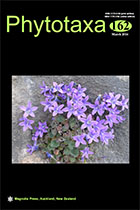Abstract
Lejeunea huctumalcensis Lindenb. & Gottsche in Gottsche et al. (1847: 762), a widespread neotropical species, is one of the most unusual taxa in Lejeunea Libert (1820: 372) owing to the variable gynoecial innovation type which may be lejeuneoid or pycnolejeuneoid, the presence of ocelli in leaf lobes and the perianth keels usually with bifid or more ramified laciniae (Reiner-Drehwald & Ilkiu-Borges 2007). In other species of this large genus, innovations are invariably lejeuneoid, ocelli are lacking and perianth keels do not produce bifid or more ramified laciniae. The generic position of Lejeunea huctumalcensis has long been controversial and the species has been assigned to at least six different genera, including Ceratolejeunea (Spruce 1884: 77) Jack & Stephani (1892: 16), Hygrolejeunea (Spruce 1884: 77) Schiffner (1893: 124), Lejeunea, Otigoniolejeunea (Spruce 1884: 77) Schiffner (1893: 125), Pycnolejeunea (Spruce 1884: 246) Schiffner (1893: 124), and Trachylejeunea (Spruce 1884: 180) Schiffner (1893: 126) (Reiner-Drehwald & Ilkiu-Borges 2007). The latter authors showed that L. huctumalcensis is an older name for L. xiphotis Spruce (1884: 227), the type species of Lejeunea subg. Otigoniolejeunea Spruce (º Otigoniolejeunea (Spruce) Schiffn.), and thus L. huctumalcensis automatically becomes a member of this group. Otigoniolejeunea was provisionally accepted by Reiner-Drehwald & Ilkiu-Borges (2007) as a subgenus of Lejeunea, with L. huctumalcensis as its only species. Other recent authors, however, have treated Otigoniolejeunea as a mere synonym of Lejeunea (e.g., Grolle 1983; Singh 2013).

